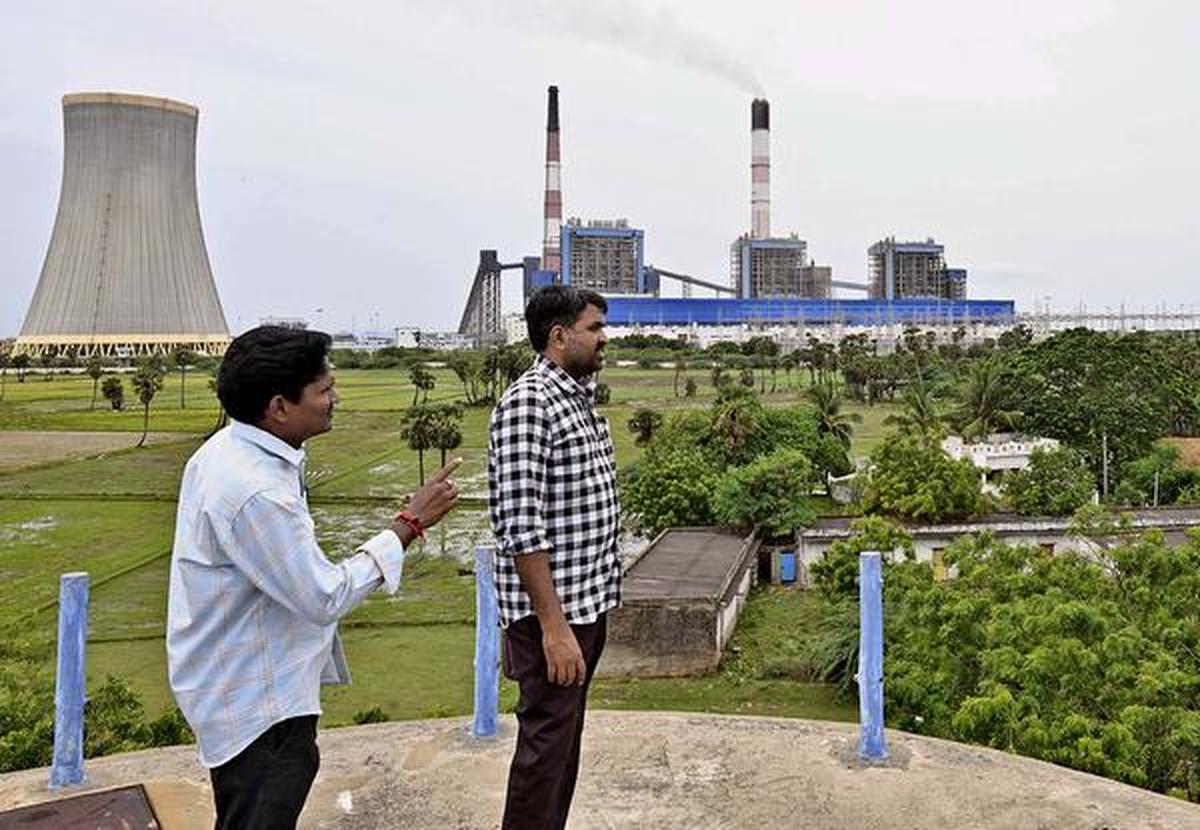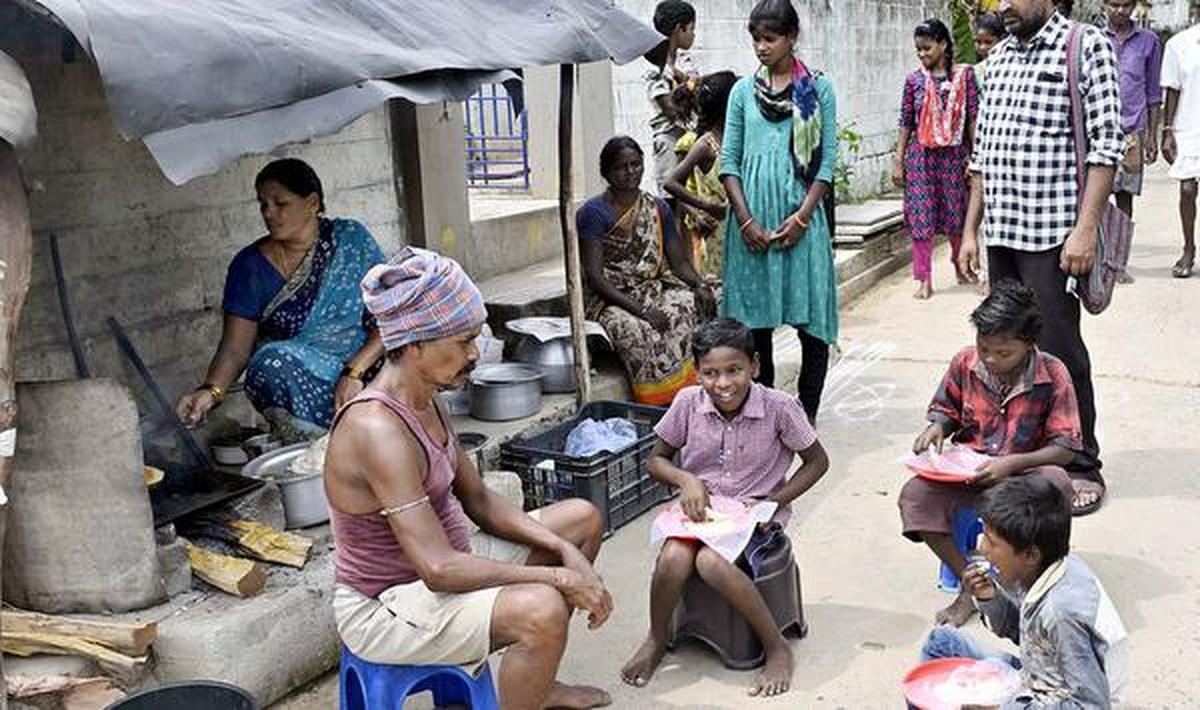The hot oil started sizzling when 42-year-old Sarojamma, a daily wage earner, lit the stove in the hut’s courtyard to make it. bastard (fritters) for two children who are 12 and 14. She squints, checks the pan for any specks of ash, and deftly flicks one away with her finger.
Sarojamma lives in Pynampuram, a predominantly tribal area located near the Sri Damodaram Sanjeevaiah Thermal Power Plant, which was set up by Andhra Pradesh Power Generation Corporation Ltd with an initial capacity of 800 MW in March 2014, in Nelaturu village, Sri Potti Sriramulu (SPSR). AP. Nellore District.
This village has a population of around 2,500 people.
A second 800-MW unit was added in February 2016 and a third 800-MW unit in October 2022.
Continuous fumes from the thermal plant’s cooling towers spread thin flakes of soot and ash over nearby villages. Students at a nearby Anganwadi school eat lunch on the verandah outside, providing food for the ashes. Local people collect street food despite health problems.
While soot and ash give sleepless nights to residents of this belt, the south and south-eastern villages of Nelaturu in Muthukuru mandal face the danger of fine particles from iron ore and coal being dumped at Krishnapatnam, India’s second largest private port.
“We have been facing this pollution problem for nearly 10 years and have represented to the district collector several times, but to no avail,” said B. Kanakaiah, sarpanch of Nelaturu panchayat.
The AP government has planned to relocate the village and rehabilitate the residents near Madaraju Guduru, about 15 kilometers away. Some houses were partially built for residents, but progress in Harijanawada (Dalit enclave) and Palem (fishing village) stalled due to alleged financial problems.
When the Krishnapatnam thermal power plant and port were proposed by the government more than two decades ago, the coastal region of Nellore was considered a potential paradise. The national media turned their attention to the perennially backward area, corporate giants explored business potential, and real estate boomed around the city of Nellore, 30 kilometers away. However, while the residents hoped for prosperity, only soot, ash and dust filled the air, along with widespread despair.
Twenty years ago, life in the vast coastal belt of the countryside was ruined. Wide beaches, serene backwaters, lush green fields and barren lands have turned brown due to soot from thermal plants, ash from treatment facilities, and iron ore and coke handled by all-weather, deep-water ports.
Residents of Muthukur, Venkatachalam (in Sarvepalli constituency), Chillakur, and Thotapalli Gudur mandals (Gudur constituency) are victims of prolonged pollution and neglect. “There has been a surge in the number of patients complaining of difficulty breathing, throat irritation, skin rashes, and worsening bronchial asthma, which has led to an increase in hospitalizations. These symptoms appear to be the result of air pollution,” said Alladi Mohan, professor of Medicine and dean at Sri Venkateswara Institute of Medical Sciences, Tirupati.
According to Dr Mohan, most of these patients are from SPSR of Nellore district, who live around the thermal power plant. They observed that pollutants like sulfur dioxide, nitrogen oxides, hydrogen chloride, polycyclic aromatic hydrocarbons, and coarse and fine particles in these emissions can cause health problems.
The government chose this belt because of its proximity to the coast, apart from the lack of nearby settlements and the availability of barren land.
While environmental degradation is expected if there is large-scale industrialization, local employment is expected to offset these negative impacts. However, thermal power plants, ports, and Special Economic Zones (SEZs) for port-based industries have failed to generate employment that had been promised during land acquisition. Some of the established industrial units are not enough for thousands of hectares. Anticipated labor force potential in the late 90s also fell short of expectations.

Realignment of port operations
The latest development is that Adani Ports and Special Economic Zone (APSEZ), which operates this port, has decided to close its container business in Krishnapatnam due to declining volumes.
For context, Navayuga Engineering Company Limited (NECL) completed the first phase of port construction in a record time of 18 months. It was inaugurated by senior Congress leader and former UPA chairperson Sonia Gandhi on 17 July 2008. The port has state-of-the-art mechanical cargo handling equipment, capable of handling bulk cargo at the rate of 100,000 million tonnes (MT) each. day, and handled 54.37 MT of cargo in the financial year 2019-20.
NECL is facing difficulties after the AP government terminated the Polavaram project and the Machilipatnam Port Project contract. In addition, external factors have led to a decline in iron ore exports, forcing companies to rely solely on coal, palm oil and the container business.
In 2021, Adani Ports and SEZ Limited acquired all the shares from NECL, the promoter company, gaining full control of the port. As Adani also owns Kattupalli and Ennore ports near Chennai, the closest functional ports to Krishnapatnam, the company has decided to reorganize its bulk cargo and container business to suit business needs and supply mechanisms.
As a result, the company reportedly focused more on bulk cargo such as iron ore, coke, edible oil, and fly ash, creating conditions to move its container business to two other ports. Sources indicated the last container ship reached Krishnapatnam port on January 26 this year.
Efforts to reach port management for clarification were unsuccessful.

Livability vs livelihood debate
The port decision has led to a political slugfest between the YSR Congress Party (YSRCP) and the Telugu Desam Party (TDP), the current ruling party, for the past few years, with heated debates focusing on issues of life and livelihood.
Krishnapatnam is in Sarvepalli constituency. During 2019-2024, it was represented by Kakani Govardhan Reddy of YSRCP, and now, after the 2024 general elections, by Somireddy Chandramohan Reddy of TDP.
Interestingly, both have served as ministers of agriculture in the past, providing insight into soil, agriculture, water and local communities in the region.
Ahead of the 2024 Elections, Chandramohan Reddy had criticized the port management for ignoring the interests of the citizens, as well as the YSRCP regime for not taking a stand.
On the other hand, Govardhan Reddy has defended the government led by his party, insisting that the port has not diverted its container business as alleged.
After the change of guard in the State, Chandramohan Reddy, as a representative of the ruling TDP, has softened his stand and renewed his appeal to the Adani Port and the SEZ management to reconsider the decision to move the container business to another port.
“This decision will leave Krishnapatnam with fly ash, iron ore and coal, collectively known as dirty cargo. We do not want Krishnapatnam to become a dumping ground. Once again I request the port authorities to consider the plight of the farmers who gave their valuable land for development the area,” said Chandramohan Reddy.
For his part, Govardhan Reddy considers the lack of port-based industries around Krishnapatnam port and SEZ as the main reason why the import/export business has not met expectations.
“Port management may have valid reasons for choosing the nature of their business and switching product lines between ports, but they cannot ignore the impact on livelihoods that will be affected by special operations in our ports,” he said.
With not many industrial units coming up, the families of the farmers who gave the land have looked hopeful. Bulk cargo handling is fully mechanized – iron ore is transported by railcar and edible oil by pipeline – resulting in minimal employment. In contrast, container traffic supports a wide range of activities, involving importers, exporters, transporters, business agents, freight handlers, cold storage, and processing units, making the region a hub of activity.
“Already, there are not many industries around the port on the scale as imagined. If the container business also moves, the processing units, cargo agents, and even the fuel stations installed around the port will have to stop operations, turning Krishnapatnam into a ghost town. The government should interfere in this matter,” said Gogula Srinivasulu, general secretary of the Trade Union Center of India for the Krishnapatnam Industrial Cluster.
Another silent victim is the local fishing community living near the Krishnapatnam coast. Due to pollution from thermal plants and dredging activities for the port, fishermen who used to go 3-4 kilometers to the sea before the port became a reality, now have to go 15 kilometers. Even if they travel longer distances, the catch remains the same, resulting in higher fuel costs and burning their pockets. In other words, fishing has become unviable.
In addition, the sea salt harvesting unit, which is spread over about 700 hectares near the coast, faced a rude shock when rising pollution brought the industry to a standstill. “About 3,000 people who depended on the salt making industry lost their livelihood,” Srinivasulu said.
Amid this bleak landscape, the promised paradise remains a distant dream. “Our fight against pollution and neglect is still a long way off, but we hope that one day, prosperity will knock on our door,” said a 38-year-old resident of Nelaturu, declining to be named.




